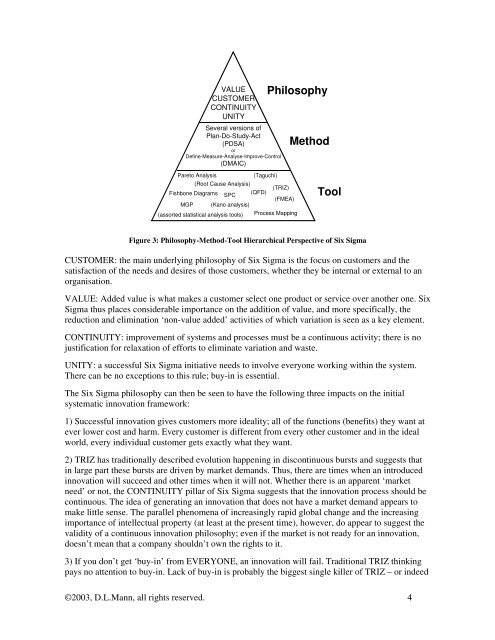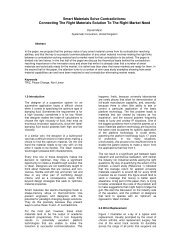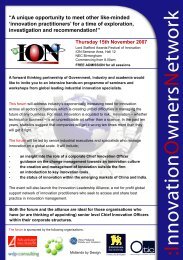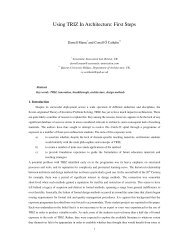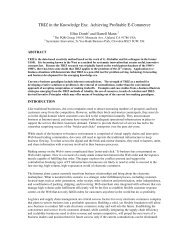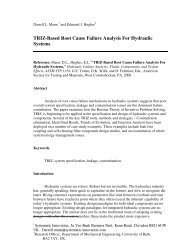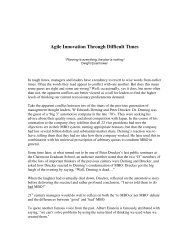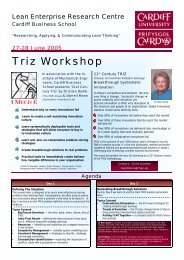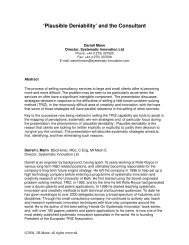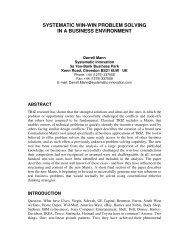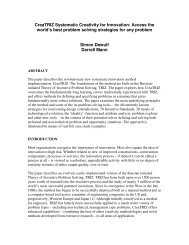Beyond Systematic Innovation
Beyond Systematic Innovation
Beyond Systematic Innovation
You also want an ePaper? Increase the reach of your titles
YUMPU automatically turns print PDFs into web optimized ePapers that Google loves.
VALUE<br />
CUSTOMER<br />
CONTINUITY<br />
UNITY<br />
Several versions of<br />
Plan-Do-Study-Act<br />
(PDSA)<br />
or<br />
Define-Measure-Analyse-Improve-Control<br />
(DMAIC)<br />
Philosophy<br />
Method<br />
Pareto Analysis<br />
(Taguchi)<br />
(Root Cause Analysis)<br />
(TRIZ)<br />
Fishbone Diagrams SPC<br />
(QFD)<br />
(FMEA)<br />
MGP (Kano analysis)<br />
(assorted statistical analysis tools) Process Mapping<br />
Tool<br />
Figure 3: Philosophy-Method-Tool Hierarchical Perspective of Six Sigma<br />
CUSTOMER: the main underlying philosophy of Six Sigma is the focus on customers and the<br />
satisfaction of the needs and desires of those customers, whether they be internal or external to an<br />
organisation.<br />
VALUE: Added value is what makes a customer select one product or service over another one. Six<br />
Sigma thus places considerable importance on the addition of value, and more specifically, the<br />
reduction and elimination ‘non-value added’ activities of which variation is seen as a key element.<br />
CONTINUITY: improvement of systems and processes must be a continuous activity; there is no<br />
justification for relaxation of efforts to eliminate variation and waste.<br />
UNITY: a successful Six Sigma initiative needs to involve everyone working within the system.<br />
There can be no exceptions to this rule; buy-in is essential.<br />
The Six Sigma philosophy can then be seen to have the following three impacts on the initial<br />
systematic innovation framework:<br />
1) Successful innovation gives customers more ideality; all of the functions (benefits) they want at<br />
ever lower cost and harm. Every customer is different from every other customer and in the ideal<br />
world, every individual customer gets exactly what they want.<br />
2) TRIZ has traditionally described evolution happening in discontinuous bursts and suggests that<br />
in large part these bursts are driven by market demands. Thus, there are times when an introduced<br />
innovation will succeed and other times when it will not. Whether there is an apparent ‘market<br />
need’ or not, the CONTINUITY pillar of Six Sigma suggests that the innovation process should be<br />
continuous. The idea of generating an innovation that does not have a market demand appears to<br />
make little sense. The parallel phenomena of increasingly rapid global change and the increasing<br />
importance of intellectual property (at least at the present time), however, do appear to suggest the<br />
validity of a continuous innovation philosophy; even if the market is not ready for an innovation,<br />
doesn’t mean that a company shouldn’t own the rights to it.<br />
3) If you don’t get ‘buy-in’ from EVERYONE, an innovation will fail. Traditional TRIZ thinking<br />
pays no attention to buy-in. Lack of buy-in is probably the biggest single killer of TRIZ – or indeed<br />
©2003, D.L.Mann, all rights reserved. 4


